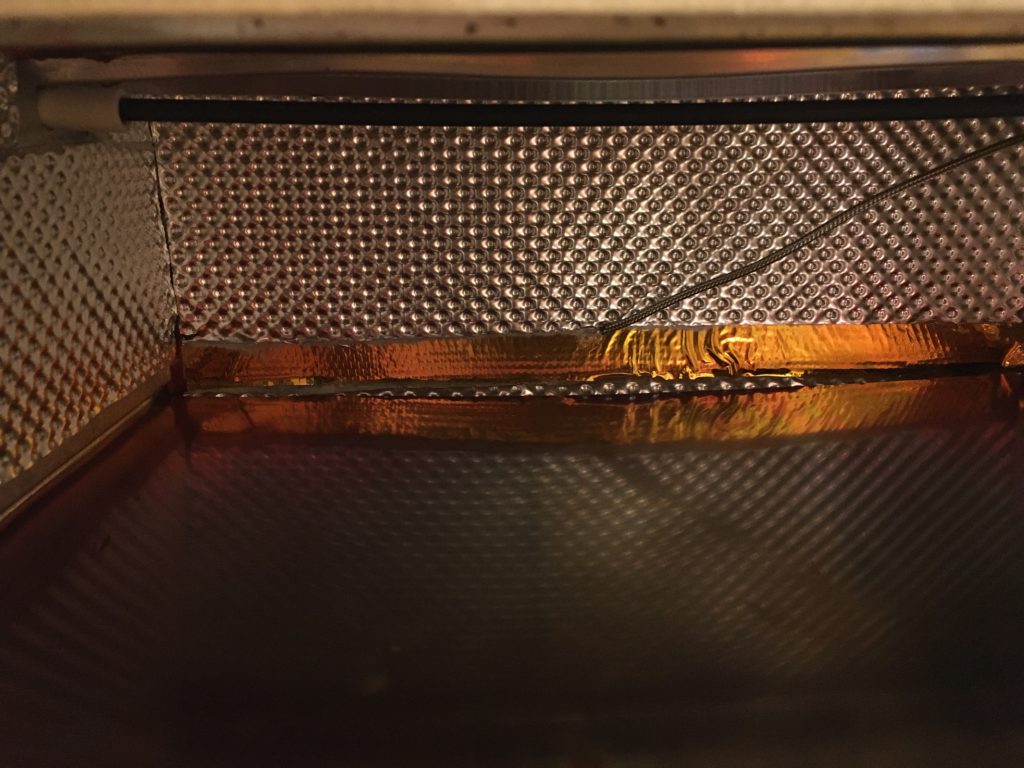

Most paste profiles will call this the soak period, Qinsi calls this the “heat” phase which seems less jingoistic. Our profile heats up to 180C and holds it for 58 seconds. Next the boards are heated close to soldering temperature to activate the flux in the paste. Heat (soak) to 180C, hold for 58 seconds. Our preferred profile for the cheap “Mechanic” lead-tin solder paste from eBay preheats to 150C and keeps it at that temperature for 60 seconds. Board and components are heated to 150C to reduce thermal shock as as we move to higher temperatures. The heat profile is divided in 5 parts: preheat, soak (heat in Qinsi terminology), solder, natural cool-down (keep in Qinsi-eese), and active cool-down with a fan. Preset 0 is user defined, and the only one we’re tried. Presets, as well as language, are set by holding RUN then turning the oven on by pressing the ON/OFF button.
Prototype reflow oven manual#
The presets don’t match the manual so we documented them on the tool list wiki. This particular oven has 5 preset profiles and 1 user programmable profile. At least in theory it’s “set it and forget it”.Ī “temperature-over-time” graph shows how the oven will heat and cool the PCBs. What’s cool about a reflow oven is that they follow a pre-programmed heat profile, ideal soldering conditions and you just push a button. At least that’s what we’re told, we haven’t tested it without standoffs to compare. The smaller boards keep the PCB off the metal grate so it heats more evenly. Several people recommend placing the board to be soldered on top of two smaller PCBs in the oven drawer. Both of these devices have large thermal mass which should provide a good test of our oven and heating profile. Three FETs with large heatsink pads might not completely reflow, and a DC power connector could deform from excessive heat.
Prototype reflow oven driver#
Sjaak’s RGB LED driver board will be our test subject today, it was part of his Mardi Gras costume. List price is about $220 for the 2 tube model in Huaqiangbei market, with a larger version 4 tube version available for about $440. We shipped back a Qinsi QS-5100 from China, this is the same brand used by Seeed Studio and SmartMaker. Solder might not reflow, heating may be uneven, boards may burn, and results may generally be inconsistent. 10 minutes later, if you’re lucky, nicely soldered boards come out. Stencil or dispense solder paste onto a PCB, place the parts, then pop it in the oven. A reflow oven is a lot more convenient though, and it follows the recommended heating profile for the solder paste.Ī reflow oven is an automated way of soldering boards. It seems like reflow hot plates are a more popular choice in most small shops because they’re smaller, cheaper, and it’s easier to monitor the reflow process. It is representative of the techniques available in the space, though we are capable of producing larger runs and of much bigger boards.After you’ve dispensed solder paste it’s time to reflow all that solder. This run of nine fairly small boards was an afternoon’s work from first paste to final oven session. Any through-hole components will be added by hand at a later moment.

The paste has turned into shiny solder joints, and all the components are attached to the board with good contacts. When the oven has finished its cycle, after about ten minutes, the boards can be removed and examined. This profile is carefully chosen to minimise thermal stress on the components and board while still soldering all the pads. Our reflow oven.įinally, the boards are placed in the oven in batches, and the temperature controller is set to step it through a preset temperature profile to reflow solder the boards. The end result of this process is a row of boards with all surface-mount components in place, awaiting soldering. The components are placed by hand on the paste-covered pads, with one person placing and another person keeping the component supply running and identifying component positions.
Prototype reflow oven full#
The full set of boards have paste applied to them, and are then arranged ready for component placement. Care is taken to clean the stencil between boards, and to ensure that the stencil is aligned with the pads on each board. The first step in this process is to clean the PCBs, then to set up the solder paste stencil and apply the solder paste through it to coat each pad with a thin layer of paste. One of the facilities we offer at Oxford Hackspace is surface-mount electronic assembly and reflow soldering, the placement of solder paste and components on entire surface-mount circuit boards and their soldering all at once in a temperature-controlled oven. We recently completed a run of a small audio input board prototype, and to show you the process in detail we’re presenting it here. The board-populating workstation set up in our electronics workshop.


 0 kommentar(er)
0 kommentar(er)
